Rubber Roof Installers Leeds
Find Rubber Roof Installer in Leeds
Get multiple EPDM Roof Installers quotes for your project today! Compare profiles, reviews, accreditations, portfolio, etc... and choose the best offer.

Matthew Boyd T/A Action Roofing
510 reviews51 Eaton Hill, Cookridge, LS16 6SE, GBWelcome to Action Roofing, Guttering and Fascias. A local, family-run roofing contractor based in Leeds. Action Roofing has been delivering roofing solutions for over 30 years. You could say it’s a tradition of ours. We understand that every client has different needs, and it’s why our reputation speaks for itself – boasting loyal customers that come back time and time again. With more than 30 years of experience throughout Leeds and its surrounding areas, we know that good quality roofing materials and excellent workmanship are essential to keep your home protected from water leaks and extreme weather conditions. That’s why we’re the roofers for you. Catering strictly for domestic customers, we pride ourselves on offering a reliable and professional roofing service that is personal and tailored to your needs. Boasting an extensive customer client base, action roofing can offer homeowners across Leeds, including Likely, Harrogate and Bradford a roofing service that is second to none and at a price you can afford. WE WILL BEAT ANY LIKE FOR LIKE QUOTE – COMPLETELY FREE – WITH NO CALL OUT CHARGE Call the experts: 0113 217 5983 A name you can trust Proud members of trusted and recognised federations. We use only the best materials from the industry’s leading suppliers. Add to this our attention to detail, which is second to none. Trained and qualified in advanced roofing techniques All of our Tradesmen are time-served as well as being trained and qualified in advanced roofing techniques, both traditional and modern, providing you with the best quality service possible. Our team are also fully insured and all new work is guaranteed by our comprehensive workman guarantee We offer free quotations and advice to all our customers so why not get in touch on 0113 217 5983.
- Services
- Why Us?
- Accreditations
- Our Team
- Testimonials
- Gallery
Get Quote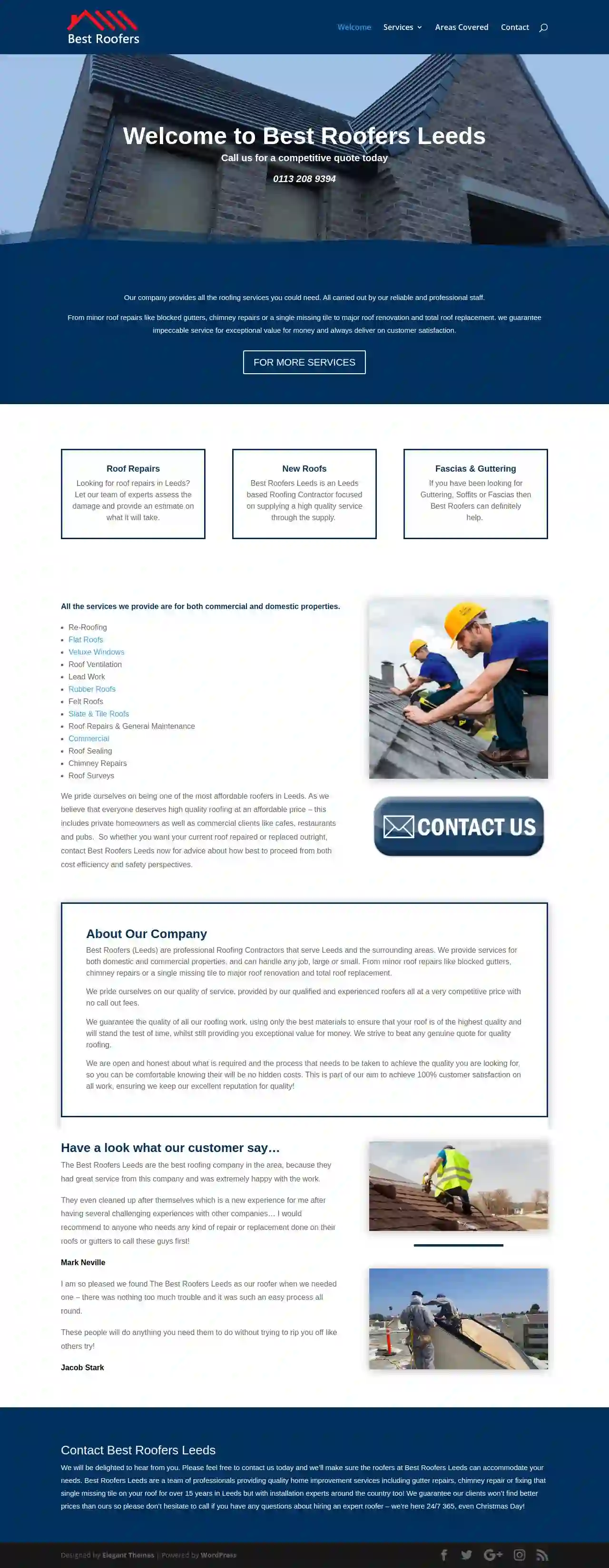
Best Roofers (Leeds)
GBWelcome to Best Roofers Leeds, a professional Roofing Contractor that serves Leeds and the surrounding areas. We provide services for both domestic and commercial properties, and can handle any job, large or small. From minor roof repairs like blocked gutters, chimney repairs or a single missing tile to major roof renovation and total roof replacement. We pride ourselves on our quality of service, provided by our qualified and experienced roofers all at a very competitive price with no call out fees. We guarantee the quality of all our roofing work, using only the best materials to ensure that your roof is of the highest quality and will stand the test of time, whilst still providing you exceptional value for money. We strive to beat any genuine quote for quality roofing. We are open and honest about what is required and the process that needs to be taken to achieve the quality you are looking for, so you can be comfortable knowing there will be no hidden costs.
- Services
- Why Us?
- Accreditations
- Our Team
- Testimonials
- Gallery
Get Quote
Watertight Roofing Leeds Ltd
4.714 reviews10 Wyther Park Mount, Leeds, LS12 2RH, GBWatertight Roofing Leeds Ltd is a leading roofing company in Leeds, offering affordable and reliable services for all aspects of roofing work. We pride ourselves on our fully qualified and highly skilled team, who are dedicated to providing a friendly and reliable service. We understand that your roof is a vital part of your home or business, and we are committed to delivering exceptional results that exceed your expectations. We offer a wide range of roofing services, including new roofs, strip and recovers, liquid rubber flat roofs, GRP fibreglass flat roofs, replacement guttering, lead work, UPVC fascia soffits, Velux windows, drone surveys, and re-pointing. Whether you need a minor repair or a large-scale project, our team has the expertise and experience to handle it all. Our working process is simple and straightforward: 1. Inspect: We listen to your needs and help identify the issue. 2. Plan: We devise a plan using our expertise and offer a solution. 3. Proposal: We provide a quick and accurate quotation for our services. 4. Install: We complete the project and ensure satisfaction. We are committed to providing a hassle-free and affordable service, where customer needs always take priority. We operate to modern standards and use the latest tools and techniques to ensure that our work is of the highest quality. Contact us today for a free quote and let us take care of your roofing needs.
- Services
- Why Us?
- Gallery
Get Quote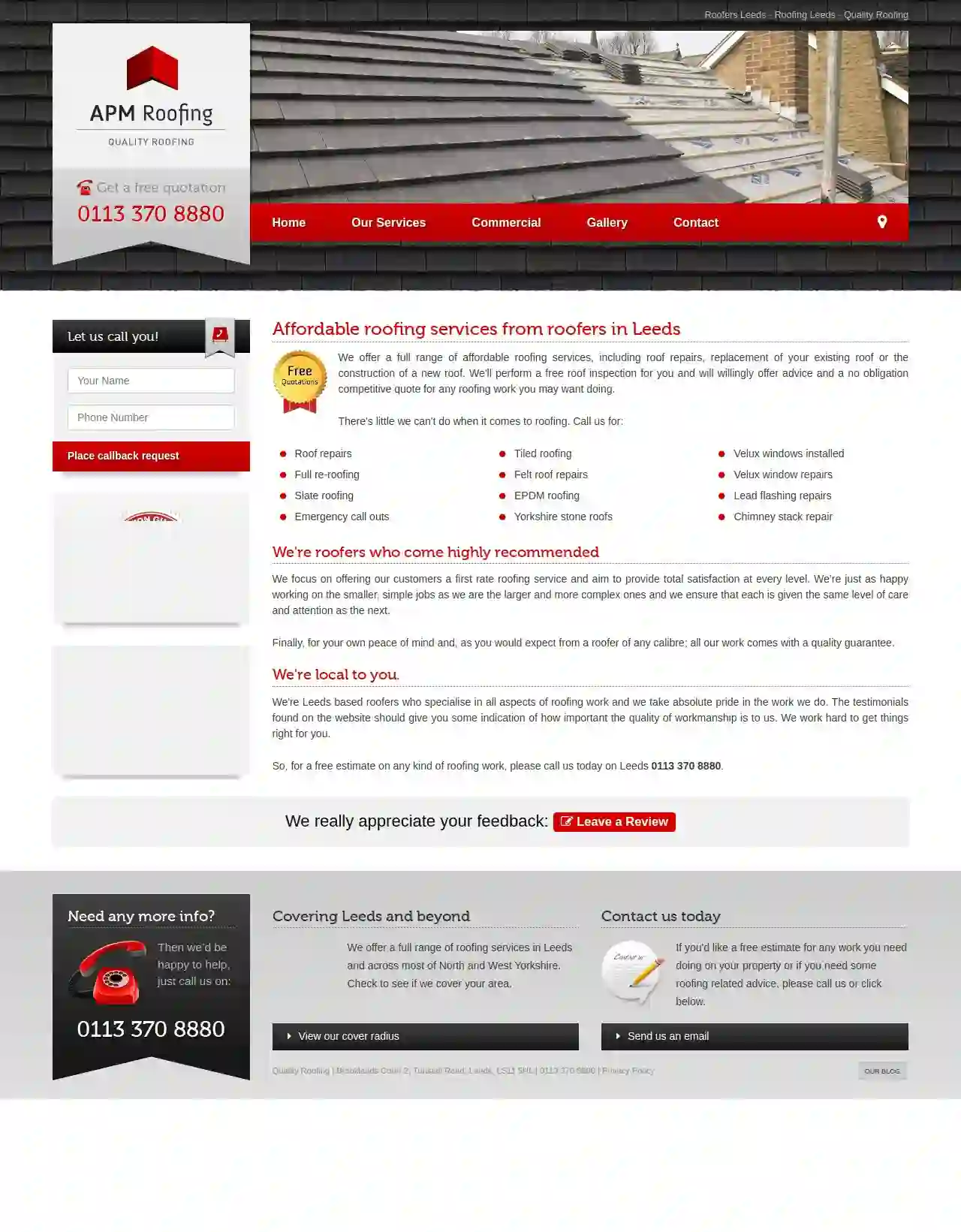
Quality Roofing
GBQuality Roofing Leeds is a local roofing company based in Leeds, offering a full range of affordable roofing services across Leeds and most of North and West Yorkshire. We pride ourselves on providing a first-rate roofing service, ensuring total customer satisfaction. Our team of experienced roofers can handle everything from small repairs to large-scale projects, using high-quality materials and workmanship. We're committed to delivering exceptional results and peace of mind to all our clients. Whether you need roof repairs, a full re-roof, or any other roofing work, Quality Roofing Leeds is here to help. We offer free roof inspections and competitive quotes, so get in touch today for a no-obligation consultation.
- Services
- Why Us?
- Accreditations
- Our Team
- Testimonials
- Gallery
Get Quote
Rodley Roofing
51 reviewsRodley Industrial Estate, Leeds, Unit 1, LS17 8AA, GBRodley Roofing is a family-run business with over 25 years of experience in the roofing industry. We pride ourselves on providing high-quality workmanship and excellent customer service. We offer a wide range of roofing services, including new roof installations, roof repairs, and roof maintenance. We are fully insured and accredited, and we are committed to providing our customers with the best possible service. Our team of experienced roofers is dedicated to providing our customers with the highest quality workmanship. We use only the best materials and equipment, and we are always up-to-date on the latest roofing techniques. We are committed to providing our customers with a stress-free roofing experience. We are a family-run business with a strong commitment to customer satisfaction. We believe in building long-lasting relationships with our customers, and we are always available to answer any questions or concerns they may have. We are proud to be a trusted name in the roofing industry.
- Services
- Why Us?
- Accreditations
- Our Team
- Testimonials
Get Quote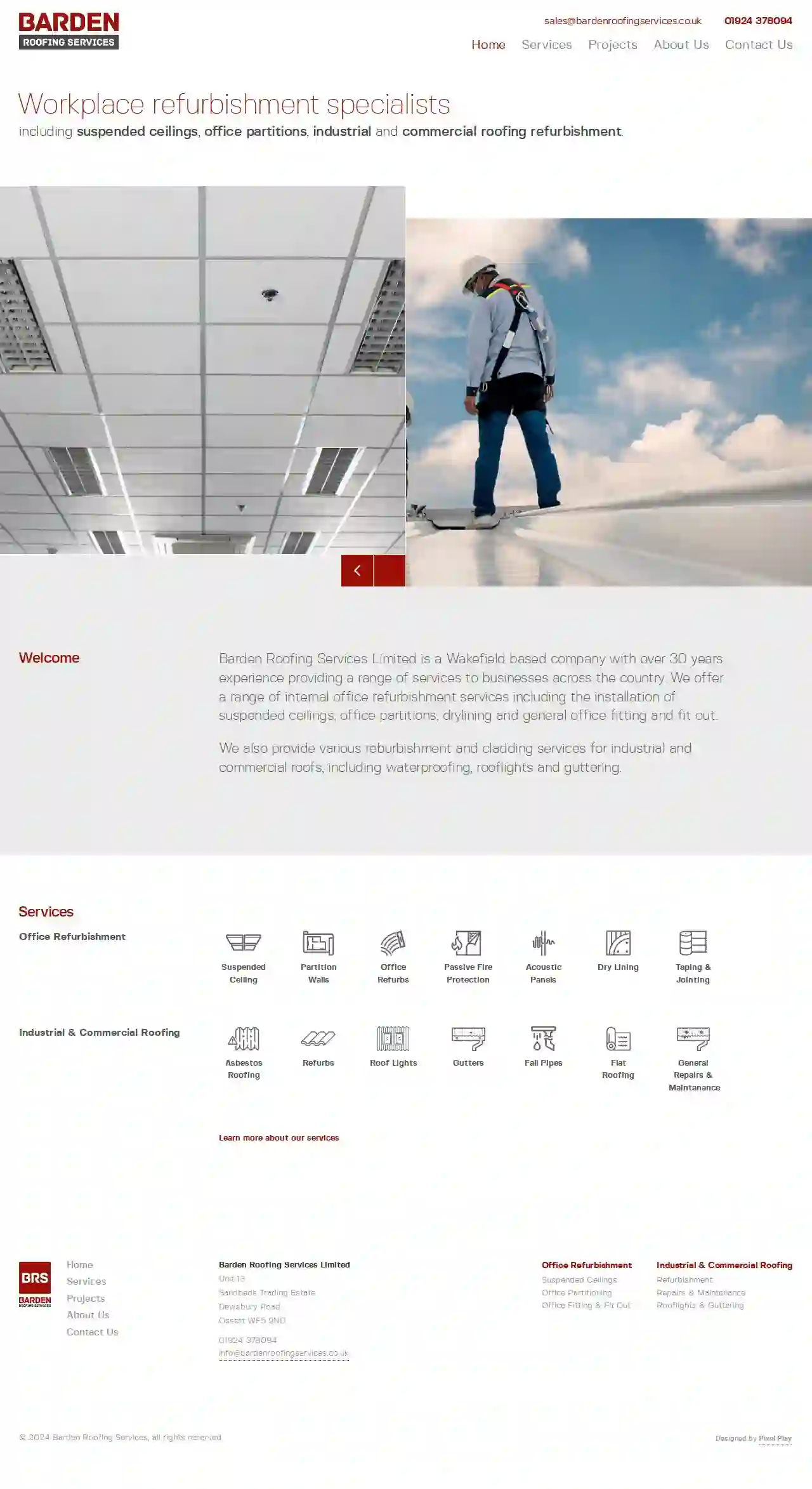
Barden Roofing Services Limited
Dewsbury Road, Ossett, Unit 13, Sandbeds Trading Estate, WF5 9ND, GBBarden Roofing Services Limited is a Wakefield based company with over 30 years experience providing a range of services to businesses across the country. We offer a range of internal office refurbishment services including the installation of suspended ceilings, office partitions, drylining and general office fitting and fit out. We also provide various reburbishment and cladding services for industrial and commercial roofs, including waterproofing, rooflights and guttering.
- Services
- Why Us?
- Accreditations
- Our Team
- Testimonials
- Gallery
Get Quote
P & T Roofing Leeds
Manor Road, Lower Wortley, Leeds, LS12 3AA, GBP&T Roofing Services Leeds is a family-run business of fully-certified professionals serving the Leeds area. We specialize in a wide range of roofing services, from large-scale projects to smaller jobs. Our commitment to excellence drives us to go the extra mile and ensure our clients are completely satisfied with our work. We offer a free consultation and quote, so contact us today to discuss your roofing needs.
- Services
- Why Us?
- Testimonials
- Gallery
Get Quote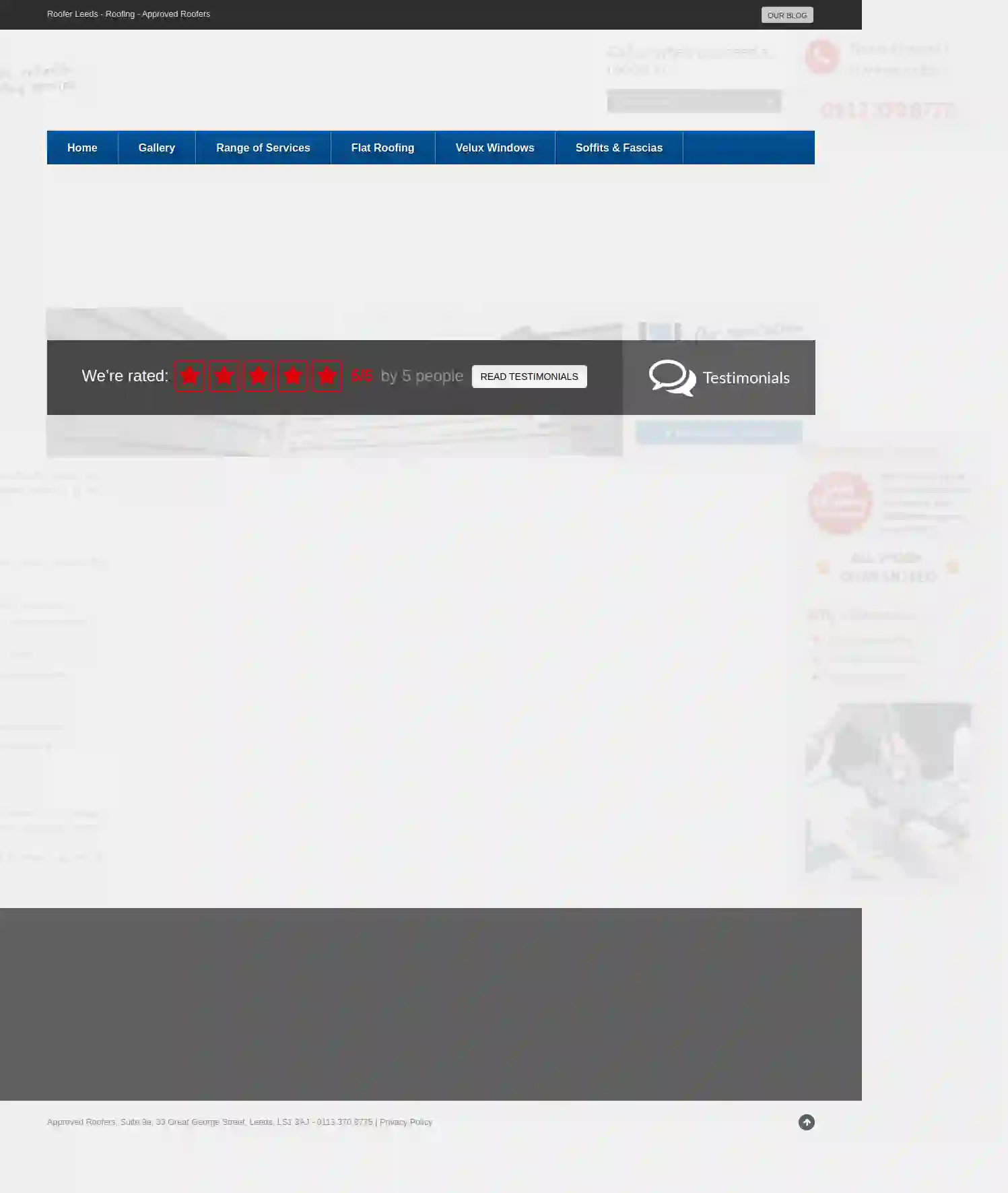
Approved Roofers
411 reviewsLeeds, GBRoofer Leeds - Roofing - Approved Roofers. Our blog. Call us when you need a roofer in: Your Location: Alwoodley & Adel, Armley & Lower Wortley, Beeston & Holbeck, Bramhope & Cookridge, Bramley, Garforth & Kippax, Guiseley & Menston, Headingley & Meanwood, Horsforth, Hunslet & Middleton, Leeds, Moortown & Chapel Allerton, Morley & Churwell, Otley & Ilkley, Pudsey & Farsley, Rothwell & Woodlesford, Seacroft & Crossgates, Yeadon & Rawdon. Need a roofer? Give us a call: 0113 370 8775. Toggle navigation Home Gallery Range of Services Re-roofing and New Roofs, Guttering, Chimney Repairs, Felt Roofs, Rubber Flat Roofing, Roof Repairs, Slate Roofing, Tiled Roofing, Fibreglass Roofs, Yorkshire Stone, Flat Roofing, Velux Windows, Velux Windows Bradford, Velux Windows Wetherby, Soffits & Fascias. View our gallery of work. Approved Roofers. We’re rated: 5/5 by 5 people. Read testimonials. Testimonials. When you need a quality Leeds roofer, choose the experts. If you're on the lookout for an excellent roofer in Leeds then we hope that you've found exactly what you've been looking for. With over two decades of experience and a wealth of knowledge, we're a great choice for all your roofing needs. We’re inexpensive, quick, thorough and everything we do is fully guaranteed.
- Services
- Why Us?
- Testimonials
- Gallery
Get Quote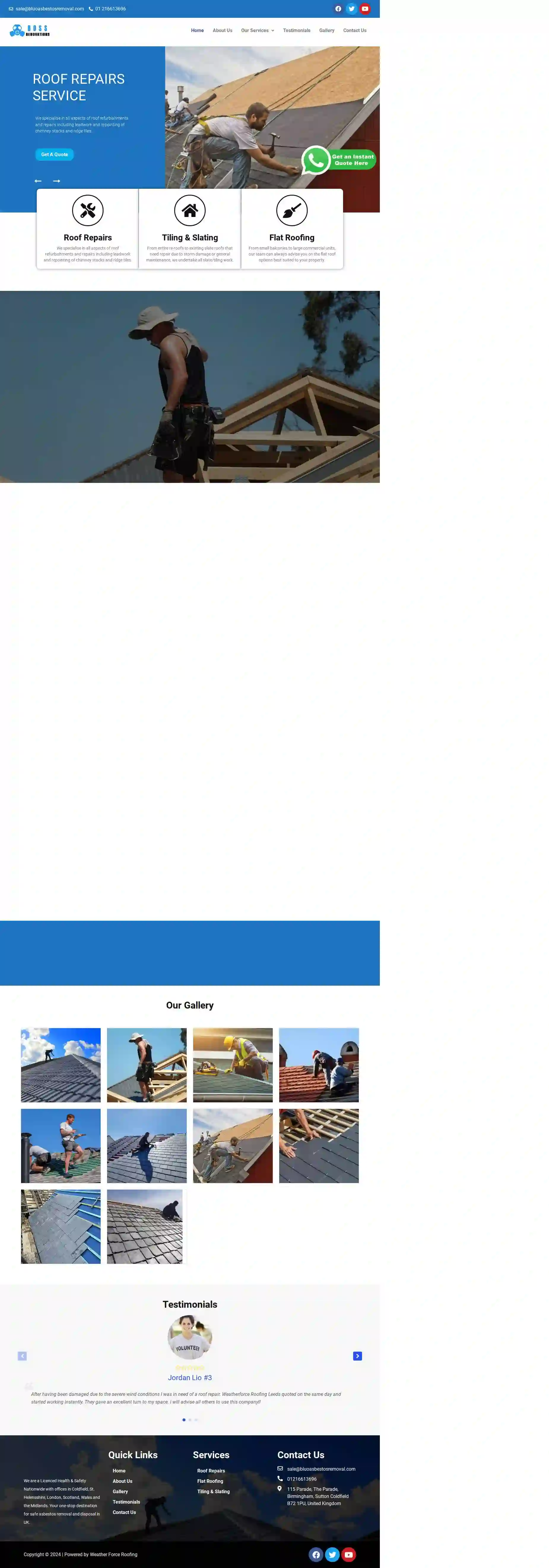
Nexus Roofing Leeds Ltd
115 Parade, The Parade, Sutton Coldfield, B72 1PU, GBServing Leeds and Bradford for over a decade, Force Roofing is one of the most reliable and professional roofing companies in Leeds and surrounding areas. We aim to be your one-stop source for all of your home improvement needs. Our goal is to provide you with cost-effective, competitive roofing services and quality installations for all of your roofing, roof repair, roof replacement and flat roofing needs. All Work Guaranteed Competitive Pricing Fully Licensed & Insured
- Services
- Why Us?
- Testimonials
- Gallery
Get Quote
Just roof repairs LTD
4.427 reviews14 Baynes Drive, YO7 3GA, GBWelcome to Just Roof Repairs LTD. We are Industrial and Commercial, Metal roofers in Leeds & the UK, a family run Roofing and Building Company with 30 years experience providing cost effective New Roofs and Roof Repairs. We are proud to say we have 100% Customer satisfaction and we are No1 for quality and price in Leeds, York, Selby, Hull, Liverpool, Harrogate, Sheffield, Manchester, Durham, Blackpool, Lancaster, and Nottingham. We provide our services in: Leeds, York, Selby, Hull, Liverpool, Harrogate, Sheffield, Manchester, Durham, Blackpool, Lancaster, and Nottingham and surrounding areas. Please call us today for a no obligation quote. Leeds Office: 0113 4508605, Dishforth Office: 01845 868367, Ripon Office: 01765 279029, Harrogate Office: 01423 203677, York Office: 01904 593547, 24 Hour Mobile Number 0771 924 8933. We will not be beaten on price or quality of work. Public liability insured. Free no obligation quotes. All work fully guaranteed. Our company Number is: - 12627383, V.A.T. Number: - 372 0435 19.
- Services
- Why Us?
- Our Team
- Gallery
Get Quote
Over 12,314+ Roofers in our network
Our roofing experts operate in Leeds and surroundings!
Roofyng.co.uk has curated and vetted Top Roofing Companies in and around Leeds. Find a reliable contractor today.
Rubber Roof Installation FAQs
- Choose cool days: The membrane is softer in hot weather, increasing susceptibility to damage.
- Wear soft-soled shoes: Avoid shoes with sharp heels or edges that can puncture the membrane.
- Distribute your weight: Use plywood planks to spread your weight if necessary, especially on a ballasted roof.
- Roof Deck Preparation: The existing roof surface is cleaned and prepared. Any necessary repairs or modifications are made to the roof deck.
- Insulation Installation (if required): Insulation boards are installed on the roof deck to improve energy efficiency.
- EPDM Membrane Installation: The EPDM rubber membrane is rolled out and positioned on the roof deck. The installation method can vary, including fully adhered, mechanically attached, or ballasted.
- Seam Sealing: Seams between the EPDM sheets or rolls are carefully sealed using specialized tapes or adhesives to create a watertight seal.
- Flashing Installation: Flashing is installed around roof penetrations (vents, pipes, etc.) and at the edges of the roof to prevent water intrusion.
- Inspection and Finishing: The installed roof is inspected for any defects or issues. Any necessary adjustments or repairs are made, and the edges of the roof are sealed and secured.
- Visual Inspections: Inspect the roof at least twice a year (spring and fall) for any signs of damage, such as cracks, punctures, or seam separation.
- Debris Removal: Keep the roof surface clear of leaves, branches, and other debris that can trap moisture and cause deterioration.
- Seam Inspection: Periodically inspect the seams of the EPDM membrane to ensure they are properly sealed and not showing signs of deterioration or separation.
- Flashing Inspection: Check the flashing around vents, pipes, and other penetrations to ensure it's in good condition and securely attached.
- Ponding Water: If you notice ponding water on your flat roof, address the drainage issue promptly to prevent damage to the roofing membrane.
- Professional Inspections: Consider having a professional roofing contractor inspect your rubber roof every few years for a more thorough assessment.
- Membrane thickness
- Installation quality
- Climate and weather exposure
- Regular maintenance
Can I walk on a rubber roof?
What is the process of installing a rubber roof?
Do rubber roofs require a lot of maintenance?
How long do rubber roofs last?
Can I walk on a rubber roof?
- Choose cool days: The membrane is softer in hot weather, increasing susceptibility to damage.
- Wear soft-soled shoes: Avoid shoes with sharp heels or edges that can puncture the membrane.
- Distribute your weight: Use plywood planks to spread your weight if necessary, especially on a ballasted roof.
What is the process of installing a rubber roof?
- Roof Deck Preparation: The existing roof surface is cleaned and prepared. Any necessary repairs or modifications are made to the roof deck.
- Insulation Installation (if required): Insulation boards are installed on the roof deck to improve energy efficiency.
- EPDM Membrane Installation: The EPDM rubber membrane is rolled out and positioned on the roof deck. The installation method can vary, including fully adhered, mechanically attached, or ballasted.
- Seam Sealing: Seams between the EPDM sheets or rolls are carefully sealed using specialized tapes or adhesives to create a watertight seal.
- Flashing Installation: Flashing is installed around roof penetrations (vents, pipes, etc.) and at the edges of the roof to prevent water intrusion.
- Inspection and Finishing: The installed roof is inspected for any defects or issues. Any necessary adjustments or repairs are made, and the edges of the roof are sealed and secured.
Do rubber roofs require a lot of maintenance?
- Visual Inspections: Inspect the roof at least twice a year (spring and fall) for any signs of damage, such as cracks, punctures, or seam separation.
- Debris Removal: Keep the roof surface clear of leaves, branches, and other debris that can trap moisture and cause deterioration.
- Seam Inspection: Periodically inspect the seams of the EPDM membrane to ensure they are properly sealed and not showing signs of deterioration or separation.
- Flashing Inspection: Check the flashing around vents, pipes, and other penetrations to ensure it's in good condition and securely attached.
- Ponding Water: If you notice ponding water on your flat roof, address the drainage issue promptly to prevent damage to the roofing membrane.
- Professional Inspections: Consider having a professional roofing contractor inspect your rubber roof every few years for a more thorough assessment.
How long do rubber roofs last?
- Membrane thickness
- Installation quality
- Climate and weather exposure
- Regular maintenance